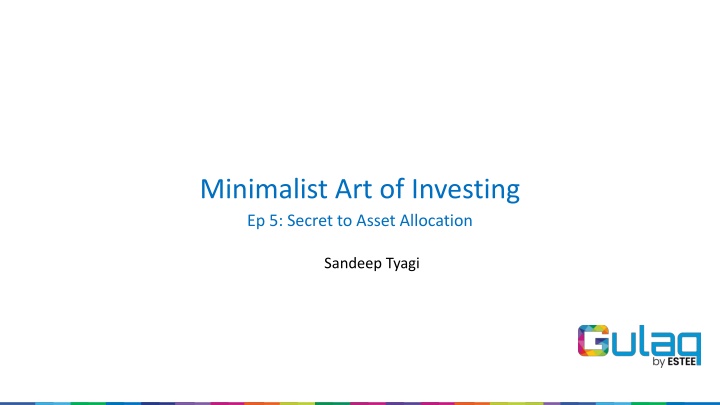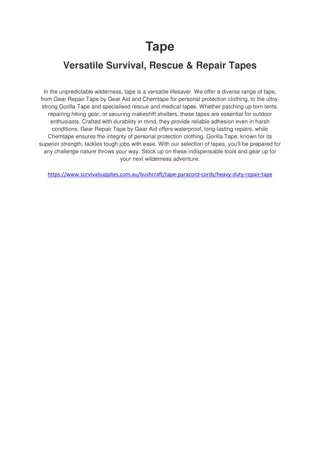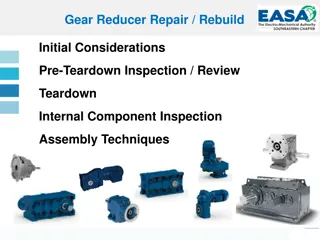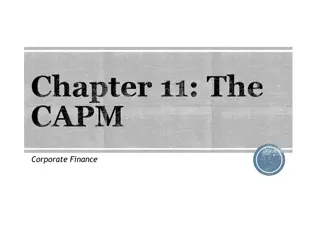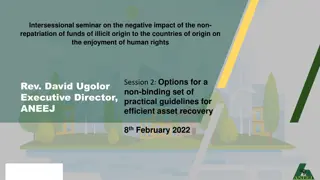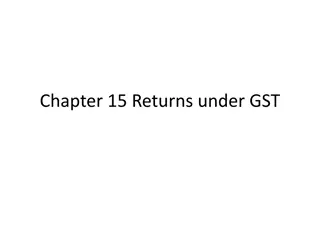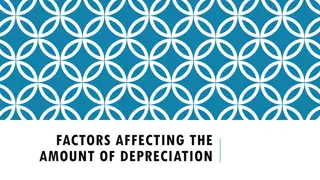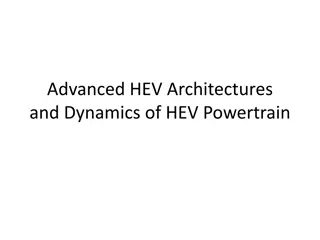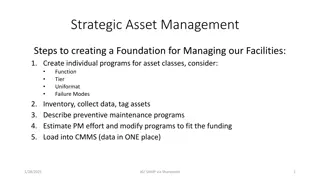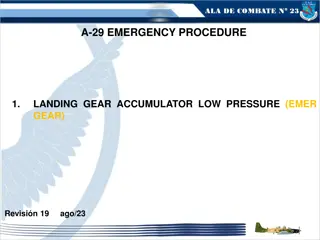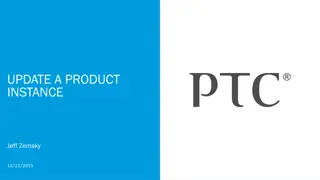Secret to Asset Allocation: Understanding Gear and Returns
Selecting the right gear is crucial in asset allocation. The mixture of fixed income and equity determines the asset allocation. Fixed income securities, such as bank deposits and mutual funds, offer different levels of safety and returns. Credit risk plays a vital role in assessing the ability of borrowers to repay debt. Understanding the risks involved in fixed income securities is essential for effective investment planning.
Download Presentation

Please find below an Image/Link to download the presentation.
The content on the website is provided AS IS for your information and personal use only. It may not be sold, licensed, or shared on other websites without obtaining consent from the author.If you encounter any issues during the download, it is possible that the publisher has removed the file from their server.
You are allowed to download the files provided on this website for personal or commercial use, subject to the condition that they are used lawfully. All files are the property of their respective owners.
The content on the website is provided AS IS for your information and personal use only. It may not be sold, licensed, or shared on other websites without obtaining consent from the author.
E N D
Presentation Transcript
Minimalist Art of Investing Ep 5: Secret to Asset Allocation Sandeep Tyagi
Recap: First Four Episodes Difficult to predict one year returns, easier to predict over long periods 10 Year Rolling returns: Sensex gave 11.2% CAGR, FD gave 8.2% CAGR 60-40 model portfolio has 10.76% average returns Savings rate of 25 to 40% is healthy Investment Planning for 3 big goals (Templates provided on Gulaq.com): Retirement Planning Buying a home children education Gear based investing: Take risk survey and find out your risk appetite Liquidity needs or goal target date has a significant impact on your asset allocation
OFFER FOR FREE CONSULTATION Follow us on social me dia Tag us Make a re que st F O LLO W U S O N Sandeep Tyagi GULAQ LinkedIn: https://www.linkedin.com/in/styagi/ LinkedIn: https://www.linkedin.com/in/gulaqnew Twitter: https://twitter.com/styagi Twitter: https://twitter.com/gulaqfintech Instagram: https://www.instagram.com/gulaqfintech/
Secret to Asset Allocation Risk 11.2% Equity 8.2% FD Return
Secret to Asset Allocation Asset Allocation of Gear 5 investment? a) 100% Equity b) 80% Equity, 20% Debt c) 60% Equity, 40% Debt d) 40% Equity, 60% Debt
Secret to Asset Allocation Gear 1 Gear 2 Gear 3 Gear 4 Gear 5 Gear 6 Equity 0% 20% 40% 60% 80% 100% Debt 100% 80% 60% 40% 20% 0% Average Returns 8.2% 9.29% 10.16% 10.76% 11.1% 11.2%
Asset Allocation - Fixed Income Selecting right gear is a major step in asset allocation. You can get any gear by mixing only 2 ingredients: Fixed income and Equity. Duration of investment and Returns are FIXED upfront in Fixed income securities. Bank Deposits Banks are regulated by Reserve bank of India, hence very safe Mutual Funds The fund holds different types of fixed income securities Debt instruments Can be issued by public or private companies Bharat Bond, corporate bonds Credit risk is important to understand
Fixed Income Credit Risk Credit Risk refers to the ability of borrower of not being able to repay the debt. Higher the credit risk, higher should be the returns. Govt and Banks: Fixed income securities offered are considered safe Lower returns, Lower risk Private Entities: Higher risk, as the repaying ability depends on business context Investors are compensated with higher returns The other risk involved is term of the investment (Lock-in period). Should be factor in investment planning
Asset Allocation: Indian Equities Stock market is the primary source of investment growth for investors Equity investing Buying a small part of a large business Profits & future growth is owned by shareholders of the company Equity investments are made through brokerage accounts One can invest in those companies which are registered on exchange through IPO Once the shares are public, they are allowed to buy or sell by investors This mechanism allows investors to own a small piece of business they like
Indian Equities Return components Equity investment generates two types of returns Dividends: Amount of money business pays shareholders at regular intervals Share price growth: Growth of business prospects over time Dividend generally varies from 2% to 5% of share price Share price growth forms the larger part of investors profit over time Stock Group Nifty 50 Time period Jan 1, 2012 to Dec 31, 2022 Total Return 247% Dividend Return 40% Stock Price Return 207%
Tax considerations Asset Short Term Long Term Equity (Domestic, Foreign, 15% ( Less than 1 Year) 10% ( >1 Year) Mutual Funds, Shares) Up to 1 Lakh profit is Tax free Listed Debt instruments Regular income tax slab (<1 10% without indexation (>1 year) year) Unlisted Debt instruments Regular income tax slab (<3 20% without indexation (>3 years) years) Real Estate Regular income tax slab (Less 20% with indexation ( >2 years) than 2 years)
Tax considerations Case study Chanchal Kumar, Manoj Kumar, and Parvat Kumar friends. Chanchal Kumar trades every month, Manoj Kumar trades once a year, and Parvat Kumar is the slowest of all. He holds the same security for 10 years. All of them have 100 to start with, investment yield is 15%, and cost of transaction are 0.05%. How much difference will it make after 10 years?
Tax considerations Case study Holding period for Equity investments for Long Term capital Gains Tax? a) >1 Year b) > 2 Years c) >3 Years
Tax considerations Case study Chanchal: Growth of 100 in 10 Years As shown earlier, tax slab of 15% as holding period is short term 380 Chanchal s 100 will grow to 335 370 Manoj Kumar: 360 Manoj will be in 10% tax slab, as holding period is 1 year 350 100 will grow to 353, 18% more than Chanchal s 340 Parvat Kumar: 330 Parvat will be in 10% tax slab, as holding period is >= 1 year 320 100 will grow to 372, 19% more than Manoj s 310 The difference is due to different tax slabs and delay in taxation. You Return get to earn return on the part of tax that you have not yet paid. Chanchal Manoj Parvat
Other Assets: Real Estate Real Estate is not part of our model portfolio due to 3 reasons: Liquidity risk: Ability to convert investment into cash depends on market sentiment Diversification risk: Due to huge investment, many investors won t be able to invest in many real estate properties Relative attractiveness of Renting over Buying However, Home ownership is a goal for many as a lifestyle choice. If that s the case for you, better account for this in your investment planning.
Other Assets: Real Estate - REITS We expect that real estate investments will become more attractive as REITS scale up. REITS are making real estate participation for retail investors smooth. REITS can be seen as a mutual fund for real estate investments Fund manager buys many real estate properties Investors can buy a small share of this portfolio REITs address 2 major risks of real estate investment Liquidity Diversification Investments in REITs can be made through stock exchange and mutual funds
Other Assets: Foreign Equity Indian Equity represents less than 5% of Global business There are several factors which impact Indian equity: Politics, Macro economics, etc. Investing in foreign equity helps in diversifying beyond India specific risk United States is world s largest market, with iconic brands listed (Apple, Google, Amazon, etc.) Investments can be made in two ways: Direct investing: Open trading with foreign brokers, or with domestic brokers who has Tie-ups with foreign stock brokers Indirect investing: Through mutual funds, ETFs, etc. Under Liberalized Remittance scheme, Indians can invest $2,50,000 per year in US equities
Other Assets: Gold A Traditional investment. Indians are the largest buyers of Gold worldwide. In 2022 alone, Indian consumers bought 774 tonnes of Gold worth INR 41,390 crore, down 3% from 2021 Gold has preserved, and for most of the time, increased its value Produced a CAGR of 9.5% over last 30 years (in INR) However, Gold as an investment has two major shortcomings Unlike Equity investment in a business, Gold is not a productive Asset It does not have predictable return pattern It is not a good hedge against inflation Gold is neither a productive asset which grows over time nor a fixed security with committed return
Other Assets: Gold Gold is a good investment, because a) Good hedge against Inflation b) Produces good returns, relative to Equity
Other Assets: Gold Gold vs Equity (1971 2021) Gold Equity 189 41 40.4 3.7 3.56 0.17 50 Years 25 Years 10 Years
Other Assets: Crypto Crypto is based on blockchain technology. It creates system which allows exchange of money without any trusted party in the middle. This revolutionary technology has wide range of applications which can be potentially built over coming decades. The potential for higher profits has attracted many young investors However, there is a lot of uncertainty in predicting crypto winners The regulations around crypto are also not clear The underdeveloped institutions which provide access to crypto are also not regulated In 2005, Mt. Gox was the largest exchange which lost lot of money due to security issues Similarly in 2022, FTX being the large exchange declared bankruptcy We recommend retail investors to stay away from crypto, till the regulations get clear.
Other Assets: Insurance Insurance products are designed to overcome risks that individual investor can t overcome. The younger the person, the more insurance they need to carry. Thumb rule is insured amount should be equal to the current value of savings over their career. Insurance covers primarily 3 risks: Health: Huge healthcare costs can ruin financial life of investors Cost of treatment is high, though the chance of needing treatment is low Early death of earning member: Every family has a earning member, who earns more and takes care of family s needs In case of untimely death of such member, insurance protects the dependents Risk of uncertainty during retirement years: Likely to happen if planned life expectancy is lower than actual lifetime
Other Assets: Annuity We plan for retirement keeping certain life expectancy in mind. However, there is a risk of uncertainty if the actual life time exceeds the planned life expectancy. An annuity is a combination of insurance and investment product It protects against how long one needs retirement savings Annuity product bridges the gap between those whose actual life time is shorter than planned, and those whose actual life time is more than planned one. So, everyone receives the same amount of return every year
Other Assets: NPS and PPF Tax efficient investment products provided by Indian Govt. NPS PPF Allows stock market investing though PPF provides fixed returns NPS managed schemes Maturity 60 years of Age Maturity Upon retirement Returns 10 to 12% (in long term) Returns 7 to 8% (historical) At maturity, 60% of the corpus can be Fully Tax exempted withdrawn. Full Tax exempted. 40% is used to buy annuity, the income on annuity is taxable. Invest up to 2 Lakhs per year Invest up to 1.5 Lakhs per year
Coming Episode Active vs Passive investing
Thank You F O LLO W U S O N Sandeep Tyagi GULAQ LinkedIn: https://www.linkedin.com/in/styagi/ LinkedIn: https://www.linkedin.com/in/gulaqnew Twitter: https://twitter.com/styagi Twitter: https://twitter.com/gulaqfintech Instagram: https://www.instagram.com/gulaqfintech/
